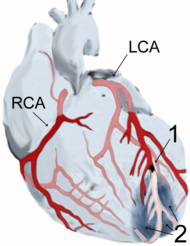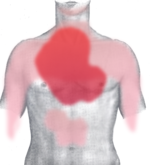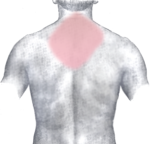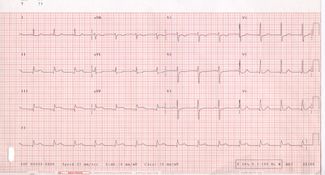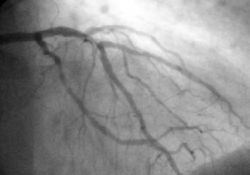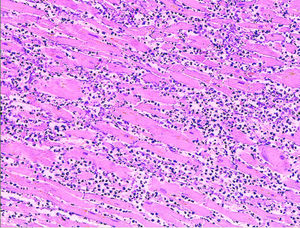Myocardial infarction
2007 Schools Wikipedia Selection. Related subjects: Health and medicine
| Diagram of a myocardial infarction (2) of the tip of the anterior wall of the heart (an apical infarct) after occlusion (1) of a branch of the left coronary artery (LAC, right coronary artery = RAC). | |
| ICD- 10 | I 21.- I 22. |
| ICD- 9 | 410 |
| DiseasesDB | 8664 |
| MedlinePlus | 000195 |
| eMedicine | med/1567 emerg/327 ped/2520 |
Acute myocardial infarction (AMI or MI), commonly known as a heart attack, is a disease that occurs when the blood supply to a part of the heart is interrupted. The resulting oxygen shortage causes damage and potential death of heart tissue. It is a medical emergency, and the leading cause of death for both men and women all over the world. Important risk factors are older age, smoking, high LDL ("bad cholesterol") and low HDL ("good cholesterol"), diabetes, high blood pressure, and obesity.
The term myocardial infarction is derived from myocardium (the heart muscle) and infarction (tissue death due to oxygen starvation). The phrase "heart attack" sometimes refers to heart problems other than MI, such as unstable angina pectoris and sudden cardiac death.
Myocardial infarctions are usually accompanied by characteristic severe chest pain and autonomic phenomena such as looking pale, sweating and feeling sick.
Initial treatment measures for someone suspected of suffering from an acute myocardial infarction include oxygen, aspirin, glyceryl trinitrate and pain relief. While these are being administered, diagnostic tests are often performed, including serial electrocardiograms (ECG, EKG), X-rays and blood tests. Further treatment may include either medications to break down blood clots that block the blood flow to the heart, or mechanically restoring the flow by dilatation or bypass surgery of the blocked coronary artery. Coronary care unit admission allows rapid and safe treatment of complications such as abnormal heart rhythms.
Epidemiology
Myocardial infarction is a common presentation of ischemic heart disease. The WHO estimated that in 2002, 12.6% of deaths worldwide were from ischemic heart disease. Ischemic heart disease is the leading cause of death in develop countries, but in developing countries it third to AIDS and lower respiratory infections.
In the United States, diseases of the heart are the leading cause of death, causing a higher mortality than cancer ( malignant neoplasms). Coronary heart disease is responsible for 1 in every 5 deaths in the U.S.. Some 7,200,000 men and 6,000,000 women are living with some form of coronary heart disease. 1,200,000 people suffer a (new or recurrent) coronary attack every year, and about 40% of them die as a result of the attack. This roughly means that every 65 seconds, an American dies of a coronary event.
Risk factors
Risk factors for atherosclerosis may also be risk factors for coronary artery disease:
- older age
- male gender
- cigarette smoking
- hypercholesterolemia (more accurately hyperlipoproteinemia, especially high low density lipoprotein and low high density lipoprotein)
- diabetes (with or without insulin resistance)
- high blood pressure
- obesity (defined by a body mass index of more than 30 kg/m2, or alternatively by waist circumference or waist-hip ratio).
These major factors are most often modifiable, so heart attacks can generally be prevented by a healthier lifestyle. Physical activity is associated with a lower risk profile. Non-modifiable factors besides age and gender include a family history of an early heart attack (before the age of 60), which is thought of as reflecting a genetic predisposition.
Socioeconomic factors such as a shorter education and lower income (particularly in women), as well as living with a partner attribute to the risk of MI. To understand epidemiological study results, it's important to note that many factors associated with MI mediate their risk via other factors. For example, the effect of education is partially based on it's effect on income and marital status.
Women who use oral contraceptives have a modestly increased risk of myocardial infarction, especially if they also have other risk factors, such as smoking.
C-reactive protein (CRP) is a sensitive but non-specific marker for inflammation. Elevated CRP blood levels, especially measured with high sensitivity assays, can predict the risk of MI, as well as stroke and development of diabetes. Inflammation is known to be an important step in the process of atherosclerotic plaque formation. Moreover, some drugs for MI might also reduce CRP levels. The use of high sensitivity CRP assays as a means of screening the general population is advised against, but it may be used optionally at the physician's discretion, in patients who already present with other risk factors or known coronary artery disease. Whether CRP plays a direct role in atherosclerosis remains uncertain.
Baldness, hair greying, a diagonal earlobe crease and possibly other skin features are independent risk factors for MI. Their role remains controversial; a common denominator of these signs and the risk of MI is supposed, possibly genetic.
Pathophysiology
The term "myocardial infarction" literally means that there is destruction of heart muscle cells due to a lack of oxygen. If these cells are not supplied with sufficient oxygen by the coronary arteries to meet their metabolic demands, they die by a process called infarction. Not all "heart attacks" lead to loss of heart muscle, particularly if the heart attack is aborted.
The decrease in blood supply has several consequences. Heart muscle which has lost blood flow long enough, e.g. 10–15 minutes, undergoes the ischemic cascade, dies (this is called necrosis) and does not grow back. A collagen scar, which does not have the ability to contract, forms in its place. Thus the heart ends up permanently weaker as a pump for the remainder of the individual's life. Recent studies indicate that apoptosis also plays a role in the process of tissue damage subsequent to myocardial infarction.
Injured, but still living, heart muscle conducts the electrical impulses which initiate each heart beat much more slowly. The speed can become so slow that the spreading impulse is preserved long enough for the uninjured muscle to complete contraction; now the slowed electrical signal, still travelling within the injured area, can re-enter and trigger the healthy muscle (termed re-entry) to beat again too soon for the heart to relax long enough and receive any blood return from the veins. If this re-entry process results in sustained heart rates in the 200 to over 400 beats per minute range, a phenomenon called ventricular tachycardia (V-Tach) or ventricular fibrillation (V-Fib), then the rapid heart rate prevents the heart from pumping blood effectively. Heart output and blood pressure falls to near zero and the individual quickly dies. This is the most common mechanism of the sudden death that can result from a myocardial infarction.
The cardiac defibrillator device was specifically designed for stopping these too rapid heart rates. If used properly, it stops and resets the electrical impulses in all heart cells —in effect " rebooting" the heart— thereby stimulating the entire heart muscle to contract together in synchrony, hopefully stopping continuation of the re-entry process. If used within one minute of onset of V-Tach or V-Fib, the defibrillator has a high success rate in stopping these often fatal arrhythmias allowing a functional heart rhythm to return.
Causes
The most common cause of heart attack by far is atherosclerosis, a gradual buildup of cholesterol and fibrous tissue in plaques in the wall of arteries (in this case, the coronary arteries), typically over decades. Blood stream column irregularities visible on angiographies reflect artery lumen narrowing as a result of decades of advancing atherosclerosis. Plaques can become unstable, rupture, and additionally promote a thrombus (blood clot) that occludes the artery; this can occur in minutes. When a severe enough plaque rupture occurs in the coronary vasculature, it leads to myocardial infarction (necrosis of downstream myocardium).
Heart attacks rates are higher in association with intense exertion, be it psychological stress or physical exertion, especially if the exertion is more intense than the individual usually performs. Quantitatively, the period of intense exercise and subsequent recovery is associated with about a 6-fold higher myocardial infarction rate (compared with other more relaxed times frames) for people who are physically very fit. For those in poor physical condition, the rate differential is over 35-fold higher. One observed mechanism for this phenomenon is the increased arterial pulse pressure stretching and relaxation of arteries with each heart beat which, as has been observed with intravascular ultrasound, increases mechanical "shear stress" on atheromas and the likelihood of plaque rupture.
Increased spasm/contraction of coronary arteries and left ventricular hypertrophy in association with cocaine abuse can also precipitate myocardial infarction.
Acute severe infection, such as pneumonia, can trigger myocardial infarction. A more controversial link is that between Chlamydophila pneumoniae infection and atherosclerosis. While this intracellular organism has been demonstrated in atherosclerotic plaques, evidence is inconclusive as to whether it can be considered a causative factor. Treatment with antibiotics in patients with proven atherosclerosis has not demonstrated a decreased risk of heart attacks or other coronary vascular diseases.
Classification
According to the ICD-10's chapter on cardiovascular disease, myocardial infarction is a form of ischemic heart disease. The latter comprises several forms of angina pectoris, acute myocardial infarction (AMI), subsequent myocardial infarction, certain complications, other acute ischemic heart diseases (such as the postmyocardial infarction syndrome), and chronic ischemic heart disease (which includes, for example, coronary atherosclerosis, old MI, ischemic cardiomyopathy and silent myocardial ischemia). The term coronary heart disease refers to heart diseases that originate from atherosclerosis of the coronary arteries. Many people have this condition without symptoms, but as it progresses it can cause myocardial infarction or angina pectoris.
Electrocardiography (ECG) allows to distinguish between different subtypes of myocardial infarction (ST-elevation myocardial infarction, STEMI and non-ST-elevation myocardial infarction, NSTEMI, discussed below).
Depending on the location of the obstruction in the coronary circulation, different zones of the heart can become injured. Using the anatomical terms of location, one can describe anterior, inferior, lateral, apical and septal infarctions (and combinations, such as anteroinferior, anterolateral, and so on). For example, an occlusion of the left anterior descending coronary artery will result in an anterior wall myocardial infarct.
Another distinction is whether a MI is subendocardial, affecting only the inner third to one half of the heart muscle, or transmural, damaging (almost) the entire wall of the heart. The inner part of the heart muscle is more vulnerable to oxygen shortage, because the coronary arteries run inward from the epicardium to the endocardium, and because the blood flow through the heart muscle is hindered by the heart contraction.
The phrases transmural and subendocardial infarction used to be considered synonymous with Q-wave and non-Q-wave myocardial infarction respectively, based on the presence or absence of Q waves on the ECG. It has since been shown that there is no clear correlation between the presence of Q waves with a transmural infarction and the absence of Q waves with a subendocardial infarction, but Q waves are associated with larger infarctions, while the lack of Q waves is associated with smaller infarctions. The presence or abscence of Q-waves also has clinical importance, with improved outcomes associated with a lack of Q waves.
Symptoms
The onset of symptoms in myocardial infarction (MI) is usually gradual, over several minutes, and rarely instantaneous. Chest pain is the most common symptom of acute myocardial infarction and is often described as a sensation of tightness, pressure, or squeezing. Chest pain due to ischemia (a lack of blood and hence oxygen supply) of the heart muscle is termed angina pectoris. Pain radiates most often to the left arm, but may also radiate to the lower jaw, neck, right arm, back, and epigastrium, where it may mimic heartburn. Any group of symptoms compatible with a sudden interruption of the blood flow to the heart are called an acute coronary syndrome.
Shortness of breath ( dyspnea) occurs when the damage to the heart limits the output of the left ventricle, causing left ventricular failure and consequent pulmonary edema. Other symptoms include diaphoresis (an excessive form of sweating), weakness, light-headedness, nausea, vomiting, and palpitations. Loss of consciousness and even sudden death can occur in myocardial infarctions and are poor prognostic indicators.
Women often experience different symptoms than men. The most common symptoms of MI in women include dyspnea, weakness, and fatigue. Fatigue, sleep disturbances, and dyspnea have been reported as frequently occurring symptoms which may manifest as long as one month before the actual clinically manifested ischemic event. In women, chest pain may be less predictive of coronary ischemia than in men.
Approximately half of all MI patients have experienced warning symptoms such as chest pain prior to the infarction.
Approximately one third of all myocardial infarctions are silent, without chest pain or other symptoms. These cases can be discovered later on electrocardiograms or at autopsy without a prior history of related complaints. A silent course is more common in the elderly, in patients with diabetes mellitus and after heart transplantation, probably because the donor heart is not connected to nerves of the host. In diabetics, differences in pain threshold, autonomic neuropathy, and psychological factors have been cited as possible explanations for the lack of symptoms.
Diagnosis
The diagnosis of myocardial infarction is made by integrating the history of the presenting illness and physical examination with electrocardiogram findings and cardiac markers ( blood tests for heart muscle cell damage). A coronary angiogram allows to visualize narrowings or obstructions on the heart vessels, and therapeutic measures can follow immediately. At autopsy, a pathologist can diagnose a myocardial infarction based on anatomopathological findings.
A chest radiograph and routine blood tests may indicate complications or precipitating causes and are often performed on admittance to an emergency department. New regional wall motion abnormalities on an echocardiogram are also suggestive of a myocardial infarction and are sometimes performed in equivocal cases. Technetium and thallium can be used in nuclear medicine to visualize areas of reduced blood flow and tissue viability, respectively. Technetium is used in a MUGA scan.
Diagnostic criteria
WHO criteria have classically been used to diagnose MI; a patient is diagnosed with myocardial infarction if two (probable) or three (definite) of the following criteria are satisfied:
- Clinical history of ischaemic type chest pain lasting for more than 20 minutes
- Changes in serial ECG tracings
- Rise and fall of serum cardiac enzymes (biomarkers) such as creatine kinase, troponin I, and lactate dehydrogenase isozymes specific for the heart.
The WHO criteria were refined in 2000 to give more prominence to cardiac biomarkers. According to the new guidelines, a cardiac troponin rise accompanied by either typical symptoms, pathological Q waves, ST elevation or depression or coronary intervention are diagnostic of MI.
Physical examination
The general appearance of patients may vary according to the experienced symptoms; the patient may be comfortable, or restless and in severe distress with an increased respiratory rate. A cool and pale skin is common and points to vasoconstriction. Some patients have low-grade fever (38–39 °C). Blood pressure may be elevated or decreased, and the pulse can be become irregular.
If heart failure ensues, elevated jugular venous pressure and hepatojugular reflux, or swelling of the legs due to peripheral edema may be found on inspection. Rarely, a cardiac bulge with a pace different from the pulse rhythm can be felt on precordial examination. Various abnormalities can be found on auscultation, such as a third and fourth heart sound, systolic murmurs, paradoxical splitting of the second heart sound, a pericardial friction rub and rales over the lung.
Electrocardiogram
The earliest electrocardiographic (ECG or EKG) finding resulting from acute myocardial infarction is the hyperacute T wave. In practice this is rarely seen, because it only exists for 5-30 minutes after the onset of infarction. Findings suggestive of MI are elevations of the ST segment and changes in the T wave. ST segment elevation is usually evident within hours of the onset of symptoms. Later, there can be loss of R wave height and development of pathological Q waves. The T waves invert which may persist for many months or even permanently.
In addition, the presence of a new left bundle branch block in the appropriate clinical setting is also indicative of an acute myocardial infarction. After a myocardial infarction, changes can often be seen on the ECG called Q waves, representing scarred heart tissue. However, a normal ECG/EKG does not rule out a myocardial infarction.
The ST segment elevation distinguishes between:
- STEMI ("ST-Elevation Myocardial Infarction")
- NSTEMI ("Non-ST-Elevation Myocardial Infarction") -- diagnosed when cardiac enzymes are elevated.
The leads with abnormalities on the ECG may help identify the location:
Cardiac markers
Cardiac markers or cardiac enzymes are proteins from cardiac tissue found in the blood. These proteins are released into the bloodstream when damage to the heart occurs, as in the case of a myocardial infarction. Until the 1980s, the enzymes SGOT and LDH were used to assess cardiac injury. Then it was found that disproportional elevation of the MB subtype of the enzyme creatine kinase (CK) was very specific for myocardial injury. Current guidelines are generally in favour of troponin sub-units I or T, which are very specific for the heart muscle and are thought to rise before permanent injury develops. Elevated troponins in the setting of chest pain may accurately predict a high likelihood of a myocardial infarction in the near future.
The diagnosis of myocardial infarction requires two out of three components (history, ECG, and enzymes). When damage to the heart occurs, levels of cardiac markers rise over time, which is why blood tests for them are taken over a 24 hour period. Because these enzyme levels are not elevated immediately following a heart attack, patients presenting with chest pain are generally treated with the assumption that a myocardial infarction has occurred and then evaluated for a more precise diagnosis.
Angiography
In difficult cases or in situations where intervention to restore blood flow is appropriate, coronary angiography can be performed. A catheter is inserted into an artery (usually the femoral artery) and pushed to the vessels supplying the heart. Obstructed or narrowed arteries can be identified, and angioplasty applied as a therapeutic measure (see below). Angioplasty requires extensive skill, especially in emergency settings, and may not always be available out of hours. It is commonly performed by interventional cardiologists.
Histopathology
Histopathological examination of the heart may reveal infarction at autopsy. Under the microscope, myocardial infarction presents as a circumscribed area of ischemic, coagulative necrosis (cell death). On gross examination, the infarct is not identifiable within the first 12 hours.
Although earlier changes can be discerned using electron microscopy, one of the earliest changes under a normal microscope are so-called wavy fibers. Subsequently, the myocyte cytoplasm becomes more eosinophilic (pink) and the cells lose their transversal striations, with typical changes and eventually loss of the cell nucleus. The interstitium at the margin of the infarcted area is initially infiltrated with neutrophils, then with lymphocytes and macrophages, who phagocytose ("eat") the myocyte debris. The necrotic area is surrounded and progressively invaded by granulation tissue, which will replace the infarct with a fibrous ( collagenous) scar (which are typical steps in wound healing). The interstitial space (the space between cells outside of blood vessels) may be infiltrated with red blood cells.
These features can be recognized in cases where the perfusion was not restored; reperfused infarcts can have other hallmarks, such as contraction band necrosis.
First aid
As myocardial infarction is a common medical emergency, and the signs are often part of first aid courses. The emergency action principles also apply in the case of myocardial infarction.
Automatic external defibrillation (AED)
Since the publication of data showing that the availability of automated external defibrillators (AEDs) in public places may significantly increase chances of survival, many of these have been installed in public buildings, public transport facilities, and in non-ambulance emergency vehicles (e.g. police cars and fire engines). AEDs analyze the heart's rhythm and determine whether the rhythm is amenable to defibrillation ("shockable"), as in ventricular tachycardia and ventricular fibrillation.
Emergency services
Emergency services may recommend the patient to take nitroglycerin tablets or patches, in case these are available, particularly if they had prior heart attacks or angina.
In an ambulance, an intravenous line is established, and the patient is transported immediately if breathing and pulse are present. Oxygen first aid is provided and the patient is calmed. Close cardiac monitoring (with an electrocardiogram) is initiated if available.
If the patient has lost breathing or circulation advanced cardiac life support (including defibrillation) may be necessary and (at the paramedic level) injection of medications may be given per protocol. CPR is performed if there is no satisfactory cardiac output.
About 20% of patients die before they reach the hospital — the cause of death is often ventricular fibrillation.
Wilderness first aid
In wilderness first aid, a possible heart attack justifies evacuation by the fastest available means, including MEDEVAC, even in the earliest or precursor stages. The patient will rapidly be incapable of further exertion and have to be carried out.
Air travel
Certified personel traveling by commercial aircraft may be able to assist an MI patient by using the on-board first aid kit, which may contain some cardiac drugs (such as glyceryl trinitrate spray, aspirin, or opioid painkillers) and oxygen. Pilots may divert the flight to land at a nearby airport. Cardiac monitors are being introduced by some airlines, and they can be used by both on-board and ground-based physicians.
Treatment
A heart attack is a medical emergency which demands both immediate attention and activation of the emergency medical services. The ultimate goal of the management in the acute phase of the disease is to salvage as much myocardium as possible and prevent further complications. As time passes, the risk of damage to the heart muscle increases; hence the phrase that in myocardial infarction, "time is muscle", and time wasted is muscle lost.
The treatments itself may have complications. If attempts to restore the blood flow are initiated after a critical period of only a few hours, the result is reperfusion injury instead of amelioration. Other treatment modalities may also cause complications; the use of antithrombotics for example carries an increased risk of bleeding.
First line
In the hospital, oxygen, aspirin, glyceryl trinitrate (nitroglycerin) and analgesia (usually morphine, hence the popular mnemonic MONA, morphine, oxygen, nitro, aspirin) are administered as soon as possible. In many areas, first responders can be trained to administer these prior to arrival at the hospital.
Of the first line agents used, the only one which has been proven to decrease mortality is aspirin.
Reperfusion
Individuals with ST elevation (known as ST elevation myocardial infarctions or STEMIs) are typically offered urgent therapies to restore blood flow to the infarct zone (reperfusion). These include thrombolytic agents, percutaneous coronary intervention or bypass surgery. Individuals without ST elevations (known as non-ST elevation myocardial infarctions or NSTEMIs) are often stabilized with antiplatelet drugs and anticoagulated. If there condition remains ( hemodynamically) stable, they can be offered either late coronary angiography with subsequent restoration of blood flow (revascularization), or non-invasive stress testing to determine if there is significant ischemia that would benefit from revascularization.
The basis for this distinction in treatment regimens is that ST segment elevations on an ECG are typically due to complete occlusion of a coronary artery. On the other hand, in NSTEMIs there is typically a sudden narrowing of a coronary artery with preserved (but diminished) flow to the distal myocardium. Anticoagulation and antiplatelet agents are given to prevent the narrowed artery from occluding.
At least 10% of patients with STEMI don't develop myocardial necrosis (as evidenced by a rise in cardiac markers) after reperfusion therapy. Such a succesfull restoration of flow to the infarct-related artery during an acute myocardial infarction is known as "aborting" the myocardial infarction. If treated within the hour, about 25% of STEMIs can be aborted.
Thrombolytic therapy
Thrombolytic drugs are indicated for the treatment of STEMIs if they can be administered within 12 hours of the onset of symptoms. Their effectiveness is highest in the first 2 hours after the artery is occluded and rapidly decreases after that. After 12 hours, it is generally believed that the risks associated with thrombolytic agents outweigh any benefit they may have to open up the infarct-related artery. Because irreversible ischemic injury occurs within 2–4 hours of the infarction, there is a limited window of time available for reperfusion to work. When reperfusion occurs later, this may result in reperfusion injury.
Thrombolytic agents include streptokinase, urokinase, and alteplase (recombinant tissue plasminogen activator, rtPA). More recently, thrombolytic agents similar in structure to rtPA such as reteplase and tenecteplase have been used. These newer agents boast efficacy at least as good as rtPA with significantly easier administration. The thrombolytic agent used in a particular individual is based on institution preference and the age of the patient.
Depending on the thrombolytic agent being used, adjuvant anticoagulation with heparin or low molecular weight heparin may be of benefit. With tPA and related agents (reteplase and tenecteplase), heparin is needed to maintain coronary artery patency. Because of the anticoagulant effect of fibrinogen depletion with streptokinase and urokinase treatment, it is less necessary there.
Thrombolytic therapy to abort a myocardial infarction is not always effective, and has a 10-20% failure rate. In cases of failure of the thrombolytic agent to open the infarct-related coronary artery, the patient is then either treated conservatively with anticoagulants and allowed to "complete the infarction" or percutaneous coronary intervention (PCI, see below) is then performed. Percutaneous coronary intervention in this setting is known as "rescue PCI" or "salvage PCI". Complications, particularly bleeding, are significantly higher with rescue PCI than with primary PCI due to the action of the thrombolytic agent.
Percutaneous coronary intervention
Although clinical trials suggest better outcomes compared to thrombolytic therapy, logistic and economic obstacles seem to hinder a more widespread application of percutaneous coronary intervention (PCI) via cardiac catheterization. The use of percutaneous coronary intervention as a therapy to abort a myocardial infarction is known as primary PCI. The goal of primary PCI is to open the artery as soon as possible, and preferably within 90 minutes of the patient presenting to the emergency room. This time is referred to as the door-to-balloon time. Few hospitals can provide PCI within the 90 minute interval.
The current guidelines in the United States restrict primary PCI to hospitals with available emergency bypass surgery as a backup, but this is not the case in other parts of the world.
Coronary artery bypass surgery
Emergency coronary surgery, in the form of coronary artery bypass surgery is another option, if cardiothoracic surgery services are available. In these heart bypass operations, an artery or vein from the patient is implanted on the aorta to bypass narrowings or occlusions on the coronary arteries. Several arteries and veins can be used, however internal mammary artery grafts have demonstrated significantly better long-term patency rates than great saphenous vein grafts. In patients with two or more coronary arteries affected, bypass surgery is associated with higher long-term survival rates compared to percutaneous interventions. In patients with single vessel disease, surgery is comparably safe and effective, and may be a treatment option in selected cases. Bypass surgery has higher costs initially, but becomes cost-effective in the long term. A surgical bypass graft is more invasive initially but bears less risk of recurrent procedures (but these may be again minimally invasive).
Monitoring for arrhythmias
Additional objectives are to prevent life-threatening arrhythmias or conduction disturbances. This requires monitoring in a coronary care unit and protocolised administration of antiarrhythmic agents. Antiarrhythmic agents are typically only given to individuals with life-threatening arrhythmias after a myocardial infarction and not to suppress the ventricular ectopy that is often seen after a myocardial infarction.
Rehabilitation
Cardiac rehabilitation aims to optimize function and quality of life in those afflicted with a heart disease. This can be with the help of a physician, or in the form of a cardiac rehabilitation program.
Physical exercise is an important part of rehabilitation after a myocardial infarction, with beneficial effects on cholesterol levels, blood pressure, weight, stress and mood. Some patients become afraid of exercising because it might trigger another infarct. Patients are stimulated to exercise, and should only avoid certain exerting activities such as shovelling. Local authorities may place limitations on driving motorised vehicles. Some people are afraid to have sex after a heart attack. Most people can resume sexual activities after 3 to 4 weeks. The amount of activity needs to be dosed to the patients possibilities.
Secondary prevention
The risk of a recurrent myocardial infarction decreases with strict blood pressure management and lifestyle changes, chiefly smoking cessation, regular exercise, a sensible diet for patients with heart disease, and limitation of alcohol intake.
Patients are usually commenced on several long-term medications post-MI, with the aim of preventing secondary cardiovascular events such as further myocardial infarctions, congestive heart failure or cerebrovascular accident (CVA). Unless contraindicated, such medications may include:
- Antiplatelet drug therapy such as aspirin and/or clopidogrel should be continued to reduce the risk of thrombus formation. Aspirin is first-line, owing to its low cost and comparable efficacy, with clopidogrel reserved for patients intolerant of aspirin. The combination of clopidogrel and aspirin may further reduce risk of cardiovascular events, however the risk of hemorrhage is increased.
- Beta blocker therapy such as metoprolol or carvedilol should be commenced. These have been particularly beneficial in high-risk patients such as those with left ventricular dysfunction and/or continuing cardiac ischaemia. β-Blockers decrease mortality and morbidity. They also improve symptoms of cardiac ischemia in NSTEMI.
- ACE inhibitor therapy should be commenced 24–48 hours post-MI in hemodynamically-stable patients, particularly in patients with a history of MI, diabetes mellitus, hypertension, anterior location of infarct (as assessed by ECG), and/or evidence of left ventricular dysfunction. ACE inhibitors reduce mortality, the development of heart failure, and decrease ventricular remodelling post-MI.
- Statin therapy has been shown to reduce mortality and morbidity post-MI. The effects of statins may be more than their LDL lowering effects. The general consensus is that statins have plaque stabilization and multiple other ("pleiotropic") effects that may prevent myocardial infarction in addition to their effects on blood lipids.
- The aldosterone antagonist agent eplerenone has been shown to further reduce risk of cardiovascular death post-MI in patients with heart failure and left ventricular dysfunction, when used in conjunction with standard therapies above.
- Omega-3 fatty acids, commonly found in fish, have been shown to reduce mortality post-MI. While the mechanism by which these fatty acids decrease mortality is unknown, it has been postulated that the survival benefit is due to electrical stabilization and the prevention of ventricular fibrillation. However, further studies in a high-risk subset have not shown a clear-cut decrease in potentially fatal arrhythmias due to omega-3 fatty acids.
New therapies under investigation
Patients who receive stem cell treatment by coronary artery injections of stem cells derived from their own bone marrow after a myocardial infarction (MI) show improvements in left ventricular ejection fraction and end-diastolic volume not seen with placebo. The larger the initial infarct size, the greater the effect of the infusion. Clinical trials of progenitor cell infusion as a treatment approach to ST elevation MI are proceeding.
There are currently 3 biomaterial and tissue engineering approaches for the treatment of MI, but these are in an even earlier stage of medical research, so many questions and issues need to be addressed before they can be applied to patients. The first involves polymeric left ventricular restraints in the prevention of heart failure. The second utilizes in vitro engineered cardiac tissue, which is subsequently implanted in vivo. The final approach entails injecting cells and/or a scaffold into the myocardium to create in situ engineered cardiac tissue.
Complications
Complications may occur immediately following the heart attack (in the acute phase), or may need time to develop (a chronic problem). After an infarction, an obvious complication is a second infarction, which may occur in the domain of another atherosclerotic coronary artery, or in the same zone if there are any live cells left in the infarct.
A myocardial infarction may compromise the function of the heart as a pump for the circulation, a state called heart failure. There are different types of heart failure; left- or right-sided (or bilateral) heart failure may occur depending on the affected part of the heart, and it is a low-output type of failure. If one of the heart valves is affected, this may cause dysfunction, such as mitral regurgitation in the case of left-sided MI.
Myocardial rupture is most common three to five days after myocardial infarction, commonly of small degree, but may occur one day to three weeks later, in as many as 10% of all MIs. This may occur in the free walls of the ventricles, the septum between them, the papillary muscles, or less commonly the atria. Rupture occurs because of increased pressure against the weakened walls of the heart chambers due to heart muscle that cannot pump blood out effectively. The weakness may also lead to ventricular aneurysm, a localized dilation or ballooning of the heart chamber.
Rupture is usually a catastrophic event that may result a life-threatening process known as cardiac tamponade, in which blood accumulates within the pericardium or heart sac, and compresses the heart to the point where it cannot pump effectively. Rupture of the intraventricular septum (the muscle separating the left and right ventricles) causes a ventricular septal defect with shunting of blood through the defect from the left side of the heart to the right side of the heart. Rupture of the papillary muscle may also lead to acute mitral regurgitation and subsequent pulmonary edema and possibly even cardiogenic shock.
Since the electrical characteristics of the infarcted tissue change (see pathophysiology section), arrhythmias are a frequent complication. The re-entry phenomenon may cause too fast heart rates ( ventricular tachycardia and even ventricular fibrillation), and lesions at the site of the sinoatrial node may cause a complete heart block (when the impulse from the atrioventricular node, the normal cardiac pacemaker, doesn't reach the heart chambers any more). Both cause the blood flow to decrease, and stagnating blood starts to clot. These blood clots may enter the circulation and get trapped when the vessel diameter decreases (for example in the lung, causing pulmonary embolism).
As a reaction to the damage of the heart muscle, inflammatory cells are attracted. The inflammation may reach out and affect the heart sac. This is called pericarditis. In Dressler's syndrome, this occurs several weeks after the initial event.
The final state can be cardiogenic shock (inadequate circulation of blood and oxygen delivery due to primary failure of the ventricles of the heart to function effectively) and death.
Prognosis
The prognosis for patients after a myocardial infarction depends largely on infarct size, left ventricular function and the presence or absence of ventricular arrhythmias. Prognosis is significantly worsened if a mechanical complication ( papillary muscle rupture, myocardial free wall rupture, and so on) were to occur.
Legal implications
At common law, a myocardial infarction is generally a disease, but may sometimes be an injury. This has implications for no-fault insurance schemes such as workers' compensation. A heart attack is generally not covered; however, it may be a work-related injury if it results, for example, from unusual emotional stress or unusual exertion. Additionally, in some jurisdictions, heart attacks suffered by persons in particular occupations such as police officers may be classified as line-of-duty injuries by statute or policy. In some countries or states, a person who has suffered from a myocardial infarction may be prevented from participating in activity that puts other people's lives at risk, for example driving a car, taxi or airplane.
